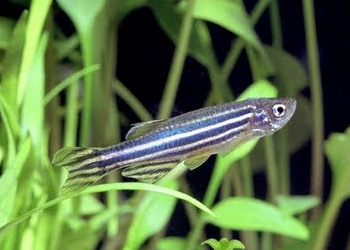


|
Main » Ethology
In 1986, Kasymyan & Ponomarev have published the results of their behavioural experiments with several tens of zebrafish, Brachydanio rerio, divided into two
training groups. In training Group 1, fish were fed (from birth to 3 month age) planktonic Cladocera and bloodworms (Chironomus plumosus), in Group 2 Cladocera and sludge worms (Tubifex tubifex).

Then fish were moved into an experimental aquarium, where they had the possibility to select one of two sections: with water extract of bloodworms and, respectively, with water extract of sludge worms (under concentration of these extracts 10-2
– 10-3 g/l). According to Kasumyan & Ponomarev (1986), fish of the first group preferred (displaying search feeding behaviour) an aquarium section with the Chironomus plumosus odor, and vise versa — fish of the second group preferred another section, with the Tubifex tubifex odor. In other words, training fish preferred the familiar feeding odors. In general and applied ethology, this phenomenon is considered in the terms of an acquired search image. An acquired search image forms in the long-term memory of an animal during its learning (both in the nature or laboratory) and is used
further as an etalon (template, specimen) to collate the receiving perceptual information. In our case, an acquired chemical search image forms in respect of an odor of some object.
How chemical search images form in other fish and crustaceans, study the basic references given below.
Basic References
Atema J., Holland K., Ikehara W. 1980. Olfactory responses of yellowfin
tuna (Thunnus albacares) to prey odors: chemical search image. Journal of Chemical Ecology 6, 457-465 Brown G.E.,
Smith R.J.F. 1994. Fathead minnows use chemical cues to discriminate shoalmates
from unfamiliar conspecifics. Journal of
Chemical Ecology 20, 3051-3061
Connaughton V.P., Epifanio C.E. 1993. The influence
of previous experience on the feeding habits of larval weakfish (Cynoscion
regalis).
...
Read more »
|
In 1997,
Ivlev has published the results of his laboratory feeding experiments with several tens of common carp, Cyprinus carpio, divided into four
training groups. In training Group 1, fish were fed only chironomidae larvae (bloodworms), in Group 2
sideswimmers, in Group 3 water louses, and in Group 4 freshwater molluscs,
respectively.
After 10
days of training, fish of each group were moved on mixed, four-component diet contained
the foregoing food items in equal parts. Interestingly, in this
mixed diet fish selected predominantly familiar foods, remembered by them in the 10-day training
period (see Table). Table. Indexes of food electivity in common carp trained before to eat one species of food (Ivlev, 1977)
Food
|
Group 1
index of electivity
| Group 2
index of electivity
| Group 3
index of electivity
| Group 4
index of electivity
|
Bloodworms,
Chironomus plumosus
| + 0.37
| + 0.19
| + 0.10
| + 0.12
|
Sideswimmers,
Corophium chelicorne
| - 0.13
| + 0.28
| - 0.19
| - 0.21
|
Water louses,
Asellus aquaticus
| - 0.15
| - 0.17
| + 0.28
| - 0.20
|
Freshwater molluscs,
Limnaea ovata
| - 0.54
| - 0.56
| - 0.51
| + 0.20
|
In trophic ecology, this phenomenon is named an acquired food electivity (acquired feeding electivity).
Generally, an index of food electivity, denoted by letter E, can range from -1 (absolute rejection) to +1 (absolute preference). E=0 means that some food is not rejected and is not preferred (that is this food is indifferent on electivity for an eater).
In general and applied ethology, the same phenomenon is considered in the terms of search image. An acquired serch image forms in the long-term memory of an animal during its learning (both in the nature or laboratory) and is used further as an etalon (template, specimen) to collate the receiving perceptual information. Without constant verification, an acquired serch image is forgotten within some time period.
In our context, search images can form in respect of food or live prey, their colors, odors and other stimuli.
In common carp (Ivlev, 1977), approximately 1.5 week of training is needed to form the relatively stable search images (with indexes of food electivity more than +0.20, see Table). Fish can switch from one search image to another, but after the corresponding training (learning). To form the more stable search images (with indexes of food electivity no less than +0.80), approximately 1 month of training is needed (Ivlev, 1977).
...
Read more »
|
|
|
CALENDAR |
|---|
| « April 2024 » | | Su | Mo | Tu | We | Th | Fr | Sa | | | 1 | 2 | 3 | 4 | 5 | 6 | | 7 | 8 | 9 | 10 | 11 | 12 | 13 | | 14 | 15 | 16 | 17 | 18 | 19 | 20 | | 21 | 22 | 23 | 24 | 25 | 26 | 27 | | 28 | 29 | 30 |
|

|




